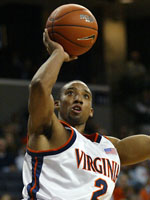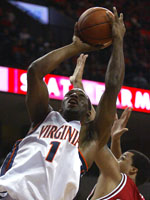Virginia (11-6, 3-2 ACC) heads back out on the road tonight for a match-up against N.C. State (11-7, 1-4 ACC) at the RBC Center in Raleigh. So far, the month of January has been an up-and-down one for the Cavaliers. A win over Gonzaga was followed by a three-game losing streak, including Virginia’s first loss at the John Paul Jones Arena.
That Stanford setback was followed with two losses on the road to ACC foes North Carolina and Boston College. The Cavaliers have since righted their ship with home wins over Maryland and Wake Forest. Before Virginia tries to notch its first road victory of the season tonight, let’s take a look at 5 Things I Learned From Gonzaga Through Wake Forest.
 |
|
J.R. Reynolds has averaged 20.3 ppg in six games this month.
|
Reynolds Deserves Some Love. Senior shooting guard J.R. Reynolds has been often criticized throughout his career at Virginia. Consistency has always been the question for Reynolds and he has still not shown a high level off consistency over the course of an entire season. But cut the guy some slack, especially after Sunday’s 40-point outburst. In the month of January, Reynolds has averaged 20.3 ppg while scoring 14 or more points in all six games.
“During the week, he and I had talked about the delicate balance between a shooter who can make plays and a player who can shoot,” said Virginia coach Dave Leitao after the Wake Forest game. “I thought he was being a little too fine with that, more trying to make plays than being able to shoot. Making the adjustment to being a shooter and judging everything off of that the threat of the shot and making plays from there, I thought he did a really good job with that and he came through for us.”
What made Reynolds’ performance on Sunday more impressive was that he did it while playing more point guard than usual due to Sean Singletary ‘s foul trouble. When T.J. Bannister transferred to Liberty over the summer, Reynolds assumed the back-up point guard position. He recorded four assists and turned the ball over only once against the Demon Deacons.
“That’s something I’ve been trying to work on,” Reynolds said of running the point. “I just try to make the simple pass.”
Mikalauskas Is Healthy And Contributing. Things were not going well for Laurynas Mikalauskas during the first month of the season. The sophomore forward was hindered by ankle injuries and struggled to get back into game shape while averaging a mere 7.5 minutes per game over Virginia’s first eight games. But the last month has been one of resurgence for Mikalauskas. Over the past six games, Lars has averaged 5.7 points, 3 rebounds, and 22.5 minutes of playing time.
Those numbers are still a bit below what he averaged during his freshman campaign, but Mikalauskas appears to be getting only better and better as the season progresses. Against North Carolina, he scored a season-high 10 points while putting forth a stout defensive effort against Tyler Hansbrough. On Sunday, he had a team-high seven rebounds while helping limit Wake Forest’s star center Kyle Visser to eight points.
“I feel 100% healthy,” Mikalauskas said. “To come back from the injuries I had, I’m feeling good now.”
Mikalauskas also brings a significant emotional element to the court. Mikalauskas’ exuberance is something that adds electricity to the atmosphere at JPJ.
Singletary Is Great But Is Sometimes Too Quick To Shoot The 3. There is no questioning junior point guard Sean Singletary ‘s talent. He scored a career-high 37 points against Gonzaga and has averaged 22.8 ppg this January. Without him, this team would be in the bottom tier of the ACC.
But that does not mean that Singletary can win games by himself. And sometimes it looks as if that is what he is trying to do. Some of the shots he takes are quite ill-advised. When those shots go in, everyone cheers. But when they don’t, Virginia often goes into a scoring slump. It is obvious that Singletary can knock down long 3-pointers with the best of them. But it would be nice if he took fewer of these early in the shot clock and showed a little more faith in the offense and his teammates’ ability to hit shots of their own.
The encouraging part is that’s essentially what happened in the most recent win over Wake Forest. After making some early shots, Singletary ended up battling foul trouble in both halves against the Deacons. When he returned to the floor, however, he didn’t have a “shoot first” mentality since Reynolds was lighting it up. He deferred to the hot hand and that is a good sign for a point guard who can get his own shot anytime. The key is picking the right times.
 |
|
Mamadi Diane ‘s scoring punch has helped UVa during some big wins.
|
When Diane Scores Big, Virginia Wins Big. Speaking of other teammates, sophomore swingman Mamadi Diane seems to be the key variable for Virginia. He has scored more than 20 points in three games this season and those games just happened to end up as Virginia’s three most significant wins of the year so far (Arizona, Gonzaga, Maryland).
Diane also helped Virginia pull away from Wake Forest with two 3-pointers in the opening minutes of the second half. With Wake Forest trying to stop Singletary and Reynolds with the triangle and two defense, Diane stepped up to fill the void.
“I really took that as a challenge,” Diane said. “I sort of smiled when I saw they were in a triangle and two because that left me open.”
In fact, Diane compared it to shooting in practice – that’s how open the looks were.
“It was almost like you were out there by yourself,” Diane said. “It was crazy.”
Singletary and Reynolds may be the fuel that makes Virginia run but Diane is the afterburner that, when utilized, helps the Cavaliers maximize their potential.
Freshmen Have Shown No Major Development Yet. I honestly expected more out of this year’s freshman class than I have seen so far. Yes, there have been some moments where the freshmen have shined, but overall they have not contributed much other than some minutes on the floor.
 |
|
Will Harris has struggled a bit during January.
|
Swingman Will Harris scored in double figures twice early in the season but has been nearly invisible in January. He has been held scoreless in three of Virginia’s past four games.
Forward Jamil Tucker has been the most productive of the freshmen, mainly due to his ability to hit the three. He scored 12 points against both Gonzaga and Maryland but did not score a point and attempted only one shot (a three, of course) against the Demon Deacons on Sunday. So far, Tucker appears in many ways to be just a gimmicky big man who can shoot from long range.
Certainly, Tucker has shown some improvement in the rebounding and defense department, but he has not made “the leap” yet. He doesn’t consistently maintain a presence (both offensively and defensively) in the paint and he likely won’t see much of an increase in playing time until that happens.
The jury is still out on swingman Solomon Tat because he missed 10 games due to injury and has seen extremely limited time on the court since returning. Against Gonzaga, his first game back, he scored two points and dished out five assists. With calves the size of tree trunks, Tat clearly meets the physical requirements to compete at the ACC level. He also would give Greg Oden a run for his money in a “Who’s the oldest looking player in the NCAA?” contest.
Forward/center Jerome Meyinsse has only played in 10 of Virginia’s 17 games this season, averaging 1.7 rebounds per game and 1.9 points. He turned 18 just last month and the logic of not redshirting him could certainly be debated. Still, Meyinsse made his first ACC appearance against Wake Forest so he could start seeing some minutes as the season winds down. Meyinsse plays with a lot of energy and you can tell he’s trying to do things the right way – communicating on defense, moving actively on both ends of the floor, and rotating to the right spots.
Note: Sabre Editor Kris Wright contributed to this story.
 Second cross-post of the group: Barney Breen-Portnoy breaks down the last month of basketball (
Second cross-post of the group: Barney Breen-Portnoy breaks down the last month of basketball (![]() ) for us.Â
) for us. 




